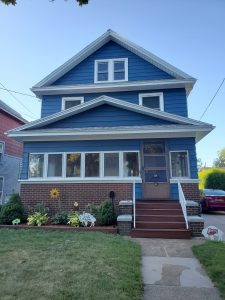
Tips to Choosing Exterior House Colors in Western New York
Posted on April 18, 2022

If your exterior is looking less than spectacular this spring, you’re not alone. The cold and snowy winters of the WNY region can cause issues on the exterior of your home. Homeowners in this region of the country should do a check on the exterior at least once a year in the spring once the winter season has passed. The life of an exterior painting project can vary depending on the conditions and weather of the area the home is in.
A professional exterior paint job will only stand up to our weather for 7-10 years and winter has a way of making deficiencies stand out. If you think you need your home painted this year, one of the first (and hardest) questions to answer is ‘what colors should we paint’. We have put together a guide to help with color selection specifically for homes in our service area, which is the greater Buffalo, NY region (WNY).
Exterior paint is the first layer of defense against the elements. It protects your home from pests, moisture and other intrusions. The lifetime of your paint will depend on the following:
- The preparation work.
- Quality level of paint.
- Seasonal changes.
- Number of coatings.
- If primer was used.
If you’re looking to update your paint to protect your home, why not have some fun with the project? Choosing new colors for your home means you have a chance to show the world a bit of your style from the curb. If color choice intimidates you, don’t be afraid to ask for help. Most painters work with professional color consultants that are happy to help.
When you choose your colors, use the 70-20-10 method.
This is the easiest way to plan for colors. It means that you should choose a color for 70% of your home. This will be covering the majority of the walls and surface area. Pick an accent color to address 20% of your home. This is for items like shutters for example. The final 10% color is picked for trim around windows and doors. Here’s how to get started.
Look at architecture.
Working with architectural elements present on your home can trip up even the most stylish people. Homes that include brick, stone or other unchangeable elements present the opportunity to naturally include colors into your color scheme.
If you do have to work around these elements, you have two options. You can leave them as-is, or you can change the color with a stain or paint. There are many products on the market to address brick and stone. They will enhance or completely change the color. Nothing is out of the realm of possibilities.
Check with local governing bodies.
Local governing bodies can have rules on what colors you can, and can’t, paint your house. Be sure to check in with local municipalities or HOAs to find out what palette you can work within. Typically, they have pre-approved color options to pick from. One benefit of this is that you know the color will look great on your home, since it’s been expertly chosen. In addition to color options, there could be rules as to what vendors you can choose.
Think about your roof.
Your roof is another one of those unchangeable items. Unless you are also replacing your roof, the color will remain the same. Working this color into your color scheme means you’re sure to have a winning combination, regardless of when and if the roof needs changed.
Here’s an example: a homeowner wants to paint their house dark gray but has a roof that has light brown shingles. That is a strange combination that might not work well. Instead, using a neutral warm cream or light beige would pair much more successfully.
You can also use the roof color as a contrast to the house paint. Use the color wheel to choose colors that will be opposite of the roof. These colors are directly across from each other on the color wheel. This approach ensures the final choices will be pleasing to the eye and have more depth to it.
Always test the paint before committing.
Seeing paint chips is one thing, but you should always test the paint on a larger scale before committing to the color. One-inch squares spread across your kitchen table look much different than a big swath of the color outside under natural light.
Test the color by purchasing small containers of the front runners. Then, paint a two-foot by two-foot square on a less visible part of your home. If this isn’t possible, use a poster board to paint the color onto. Test the color against trim colors and be sure to look at it in different lights at different times of day.
Play with shades.
The easiest way to have a stellar color palette without stress is to go monotone. If you really are set on blue or gray, use it. Work with a less saturated version of the color to paint the majority of your house, go more saturated for the shutters or doors and even more so for the trim. This will always give you great results that are perfectly paired.
Get help.
If you are consulting with a painting company to do the work on your house, inquire about color consultation. Most painters will either have a color consultant on staff or have one they work with regularly. These professionals have trained in color choices and can help you set your project up for success.
When you’re ready to get started, contact us. Our crews and consultants are here to help your house be beautiful (and protected from the elements). Schedule a free, no-obligation estimate with us today.






